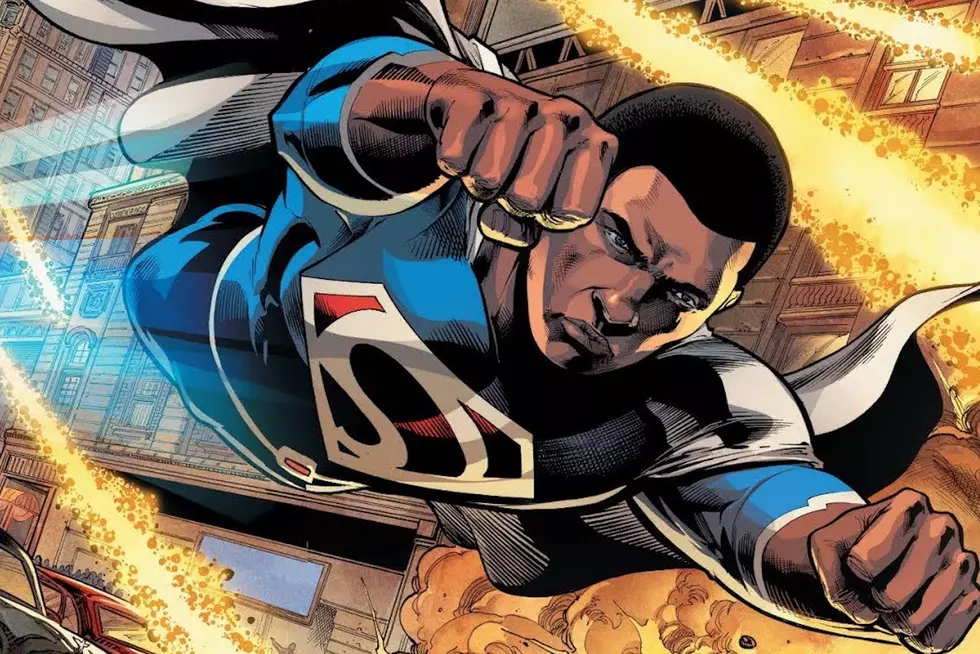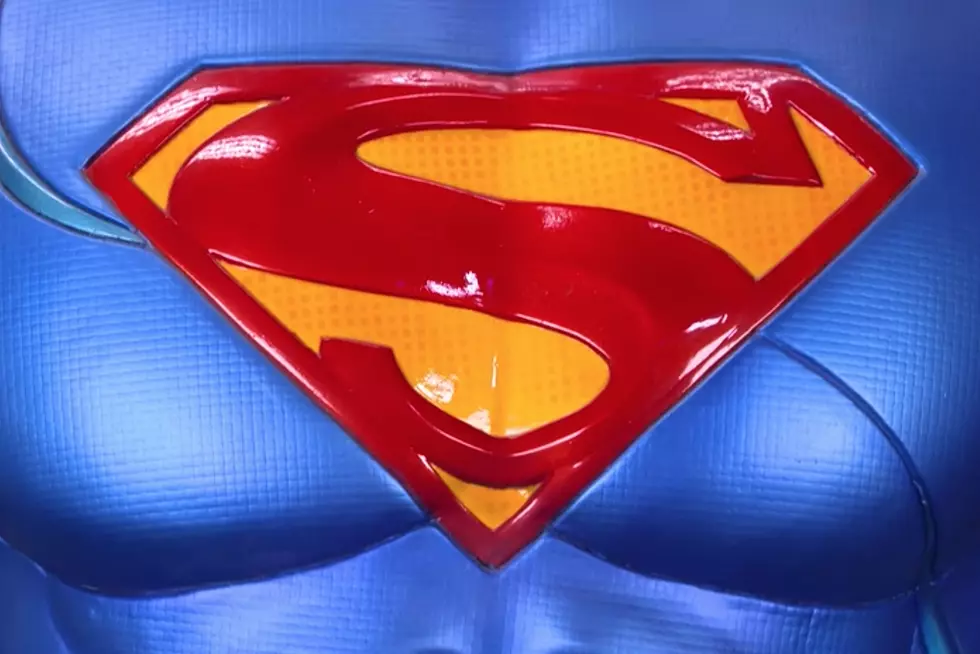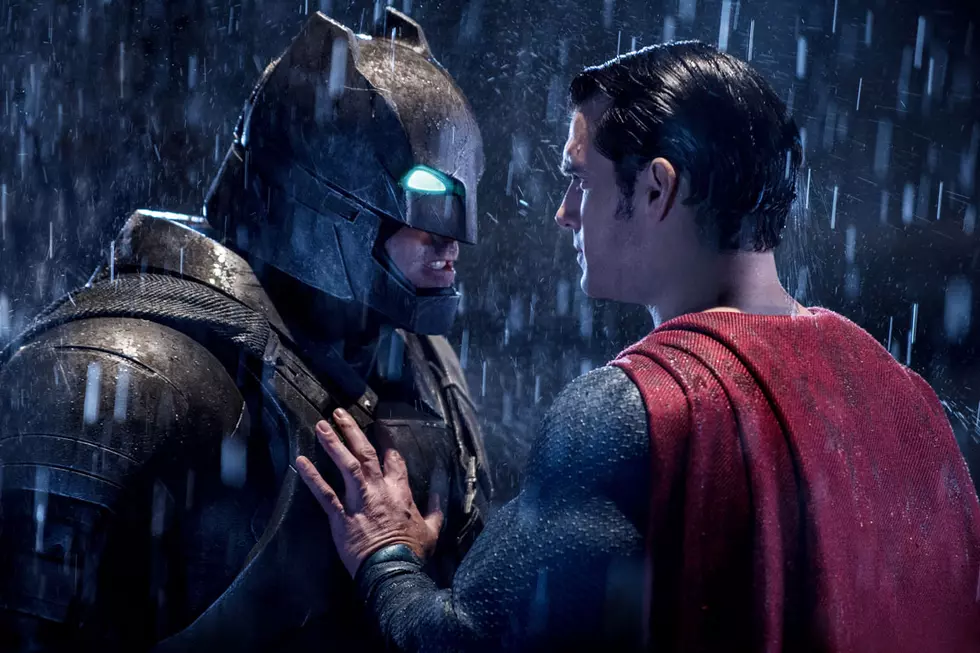![Joe Keatinge On ‘Adventures Of Superman': ‘When Am I Ever Going To Have This Chance Again?’ [Interview]](http://townsquare.media/site/622/files/2014/03/JK01.jpg?w=980&q=75)
Joe Keatinge On ‘Adventures Of Superman': ‘When Am I Ever Going To Have This Chance Again?’ [Interview]
Over the past year, DC's digital Adventures of Superman anthology has played host to some of the most exciting creative teams working in comics today. With the current story, though, the scale of the whole project has gotten much bigger in both creative team and subject matter. Writer Joe Keatinge has been joined by an incredible roster of talent that includes Ming Doyle, Brent Schoonover, Dave Williams, Tula Lotay and Jason Shawn Alexander to chronicle a three-part epic that spans Superman's life from 1939 all the way to the end of time, and the end result is one of the best Superman stories I've read in a while.
To find out more behind how the project came to be and what he wanted to accomplish with it, I spoke to Keatinge and got his thoughts on the reason for multiple artists, the influence of Jack Kirby on the story, and how he compares and contrasts Superman and Dracula.
ComicsAlliance: It seems like every time I talk to you, you have a new and exciting project going on, and we talk pretty often.
Joe Keatinge: That's good news, for me. Thank you. I'm glad that's the case.
CA: You're getting ready to launch Shutter, and next week is the final chapter of this big Adventures of Superman story. How long ago did you start working on Superman?
JK: It was a long time coming. In fact, it might've been this time last year that I got an email from Alex Antone, the editor of the digital comic. It was just like "Hey, man, I like your stuff." We'd never talked before or anything, he just said "We're doing this Adventures of Superman anthology, are you interested?" I said of course, and we got on the horn and ran through the whole concept. It's an anthology, you can do whatever you want, you can have Superman wear underwear or whatever...
CA: They're trunks, Joe. They're not underwear. They're trunks.
JK: [Laughs] Excuse me, trunks. I respect that correction. But yeah, I was jut like "that would be awesome." He was asking for done-in-one pitches, but the selfish part of me was like, when in comics history have people been told "just do whatever you want with Superman, in any continuity"?
It's such a rare thing, and I think the idea that he was having was that if we done-in-one stories, we can have more creators involved, and so I was like "well what if we do one story with a bunch of people? It's thirty pages, but there's five different artists involved doing different eras of Superman." Because at first, my immediate gut reaction was that if you give me Superman, my favorite era of Superman is when he's got a lion head because of all the Red Kryptonite, and I want to do something in that era. But then, it would be cool to do a Fleischer style story, something earlier, or something that nobody's ever seen before. So I just thought, screw it, I'll do it all. I'll do everything.
So I thought that we could do this three-part story where each part took place in a different era, and then, just because he's kind of the Holy Grail, I thought "I'll throw Kamandi in there and make that work." I needed a framing sequence, so, Kamandi in the future. That's perfect. Then I gave them the pitch and thought he was going to reject all of this. If you read it, there's a part where, in 1939, Superman, Batman and Dracula fight Frankenstein's monsters.
CA: Oh, we're going to talk about that, Joe. Do not worry.
JK: Yeah, I was like "This is the Chris Sims panel." But then, he sent it to Hank Kanalz, and they were both like "Yeah, this is fine." What?
And then came the part where we were casting the artists, and it was awesome. They said they were talking to Ming Doyle. She's awesome for Kamandi, done. Then I knew Brent Schoonover, and he had just posted some designs for Golden Age Superman, and Alex said "What about him?" He's a buddy, let's put him on there. Then he mentioned that Dave Williams was looking to get back into doing comics regularly, he's awesome. Then, in the third part, there's one page in 1926, and I wanted this kind of Days of Heaven look, with the farmland, and he was talking to Tula Lotay, and she's perfect, and then the rest of the third part takes place at the end of time, and it's kind of a ghost story, in a way, and he suggested Jason Shawn Alexander. I love the stuff he did on B.P.R.D., so he's perfect.
So yeah. It became this whole undertaking, and now it's finally a real thing. It's one of those things where I started working on it a year ago, and now it's a real thing. Now that it's finally here, it's hard to keep up with. Time really speeds up. It felt like forever waiting for it to come out, and now that it's here, it's gone by so quickly.
CA: I've had that experience too, where you work on it forever, and then it's out, and it's done.
JK: Exactly.
CA: I did want to talk about the multiple artists. A lot of the Adventures of Superman and Legends of the Dark Knight books are done by a specific writer/artist team, which is great, because you get to see teams that don't usually work on those characters. But with this, you've got this big story and all these different artists handling it. That was something you pushed for from the start?
JK: That was my initial suggestion, even before I had the story formulated. Part of it was completely selfish, in that I wanted to have the most amount of space to tell the biggest story with Superman. I don't know, when else in my career is someone going to tell me to do whatever I want with Superman? Probably never. But then, I was thinking about it, and the best way to use people is to set it all in different time periods, because then it has a different impact. When you switch from Ming Doyle to Brent Schoonover or Dave Williams, it's interesting from a mechanical perspective, how you're telling your story and your ability to work with different artists to convey it. That was what I wanted to do.
One of the things I love so much about Superman and the bigger characters, it applies to Batman, certainly, is just the different interpretations over time, and how much of the core of the characters remain the same over different iterations in different media, especially in comics. You go from the initial 1938 punching out politicians, leaping over buildings, to the Silver Age, lion head sometimes, every superpower ever, then getting more developed in the Neal Adams stuff. I always wanted to convey that, at least in a microcosm.
CA: Was that a challenge in terms of scripting? To cram in this story that starts in 1939 and goes to the end of time?
JK: It wasn't hard in a bad way at all. I've heard Jonathan Hickman talk about this, too, and I think I've heard Fraction talk about it: the idea of giving yourself games with every script. The game of this one was to take thirty print pages, sixty digital pages, to tell the biggest Superman story that I could possibly do. It was fun.
That's one of the reasons I love comics so much, the ability to do that. Can you even imagine trying to make a movie of that? It would drive someone insane. It's so much more fun to do it with comics. So yeah, it was a challenge, but that was the point. Why not? Why take the easy way out? I keep saying this, but it's run in my head so much over the past year: I'm fairly certain I'll never be given the chance again to cut loose on Superman like this.
CA: The thing that I noticed is that there's so much that happens, but these pages use splash panels, they're three and four panels per page, so the pages don't feel like they're overstuffed. Everything feels well-paced. Did you end up cutting anything out?
JK: No, not really. I'm trying to think. I would love to write more comics about Superman in 1939, but that part was done.
I think my general philosophy of comics, and it changes over time and with every project, but the general idea is to tell the most with the least. You've got Ming Doyle drawing comics, why would you cover her art with a bunch of word balloons? What are you going to add? It's a visual medium, man. You want to write a bunch of prose, write a novel. Write a book. What are you even doing? [Laughs]
So how can you take the storytelling mechanics of comics and tell the most with the least? That's one of the things that's so great, among the other things. You can do so much without being overbearing. When I look at comics that are 90% text, it just drives me nuts. Sometimes it works. That's how I do it.
CA: There are a few specifics that I wanted to talk about, and one of them is obviously that there's a framing sequence, and then the first thing we see -- the first time we see Superman in this comic -- is a team-up with 1939 purple gloves, double guns Batman, and Dracula, fighting Frankenstein's Army in a gothic castle that is "just outside Metropolis."
JK: [Laughs] I'm glad someone else appreciated that. I love that idea. The idea of the castle came from the Fleischer Studios stuff. There would always be that stuff. A mad scientist would have some ridiculous castle right outside of Metropolis city limits. What's the real-world equivalent of Metropolis, New York? That's like having a castle in the middle of New Jersey. But I love that absurdity of the Golden Age stuff. "There's a castle outside of Metropolis, whatever, go deal with it!"
I think the Dracula stuff came from the Universal Monster era of the time and the transition from Dracula. The truth of the matter, what it boils down to, is that I thought it would be cool to have Dracula team up with Batman and Superman, and again, when else am I going to get that opportunity? But part of it was to show the transition of old fiction, old fantasy and science-fiction, to superhero fiction. Stoker to Shuster. I thought that was a cool element to have in there.
CA: I'm a fan of adventure hero Dracula, and what struck me about it is that the usual setup for that idea is that Dracula is the bad guy and Frankenstein's Monster is the good guy, and here, you switch that around. It's a heroic Dracula. It's a Batman-Dracula-Superman team-up. Why did you want Dracula to be a good guy -- in this one panel that I'm asking you all these questions about. [Laughs]
JK: I seriously thought at one point, I'm not just saying this, "If this thing totally bombs critically, I know one guy who will love this one panel."
CA: You know you're going to get one five-star review, two pages in.
JK: Five stars for one page! So, yeah. I always kind of figured that Dracula's immortal, he probably goes through different stages of his life. By 1939, maybe he'd go in another direction. It just seemed right and natural.
CA: That's interesting, because you have Superman as an immortal in this story, and he's eternal and unchanging. He's always the best of us.
JK: Right.
CA: So, and this might be the dumbest interview question I've ever asked, is that the difference between Superman and Dracula?
JK: Kind of! I love that notion, so I'm going to say yeah. I feel so silly getting into it like this, but in a way, it is kind of how we deal with our own sins in our lives in general. Superman is what we want to be, and maybe Dracula is what we actually end up being in our lives. I've had times in my life that I regret, when I was kind of a dick. I mean, I've never been a vampire, I don't know what that's like. But yes, that's a very key point I was trying to make with that Superman-Batman-Dracula page.
CA: The other thing I wanted to talk about is that there's a huge Kirby influence in this story, which is interesting, because it's not in the way you usually see. Usually when you see Kirby stuff applied to Superman, you see Darkseid, the New Gods, and historically, there's been a connection between Superman and Kamandi. The idea that Superman's costume is this precious relic in the days of Kamandi, I love that. But here, you don't stop with using the characters. Kamandi shows up, the New Gods show up briefly in the second part, but there's a lot of phrasing that's very Kirby. Professor Potter tells him "Behold the World That's Coming," which is from OMAC.
JK: And the first line of the story is "there came a time when the old Earth died," which is obviously from New Gods #1.
JK: I think New Gods #1, page one, is the best opening of a comic, period. I was just thinking about this because there's a Kirby group on Facebook, and Scott Dunbier was posting scans from the New Gods Artists Edition, and one of the first ones was that page. I was obsessing over it, despite the fact that I've read it so many times, just seeing the original art. It's such a great way to start a comic, with Ragnarok. That line is burned into my brain, it's come up in a couple of things I've done.
Kirby's a huge, huge influence on me. I always hated having stickers on my laptop, I never lied that idea. Why, I don't know. But at New York Comic-Con last year, the Kirby Museum was selling stickers of Kirby's signature, and I finally had something I could put on my laptop. Around the same time, I figured out how you can have your desktop wallpaper switch out, and someone posted these amazing scans of Kirby double-page spreads, so my background for the last year and a half has been Kirby spreads, every five minutes, a new one.
My point is, obviously, I have this obsession with Kirby's work. Of course Fantastic Four, of course Darkseid and Orion, but Kamandi? '70s Kirby is my favorite era of his stuff. Kamandi, OMAC, 2001: A Space Odyssey, particularly #5, is one of my favorite comics of all time. There's a lot of his stuff that the people who love Kirby, which I hope would be everyone, is into. The fact that he basically invented adventure comics as we know them, double-page spreads, whatever. There's all that, but my favorite thing about him is the sense of scale he brings to everything. Even at the age I'm at, if I discover something new of his that I haven't read before, or recently, I'm still surprised by it. Especially when you get to the later stuff like Silver Star and Captain Victory, it's so nutty. Even the stuff he didn't write, like Super Powers. I love it.
So Kirby's all over my work, just in general, but I felt for this comic in particular, since I had a 30-page comic to go from the '30s to the end of time, that sense of scale is definitely Kirby. So there were a few direct nods, but some of it is just in my comics-writing DNA at this point.
CA: It does have the sense of a Kirby story, that you're opening at the apocalypse, at the deat of Earth, and telling this big story behind it. So since it's such a big story, and you've mentioned that you don't think you'll have this chance again, is this a story where you've gotten everything you wanted to do with Superman onto the page here, or do you want to do more that you don't think you'll get to?
JK: I've debated saying this publicly before, but I think I'm going to: If I was given free reign, completely, to do whatever I wanted to do with Superman, this story would be the prequel to that run. My run would start where this ends. I don't want to say too much more than that, because I like to keep my ideas to myself, but theoretically, Superman is a character I could write forever. If you read this, this would be #0 for, potentially, a much larger run. I have a massive story in me. Will I be able to tell it with Superman? I don't know. We'll have to see.
"Strange Visitor" is available digitally in Adventures of Superman #46-48.
More From ComicsAlliance









